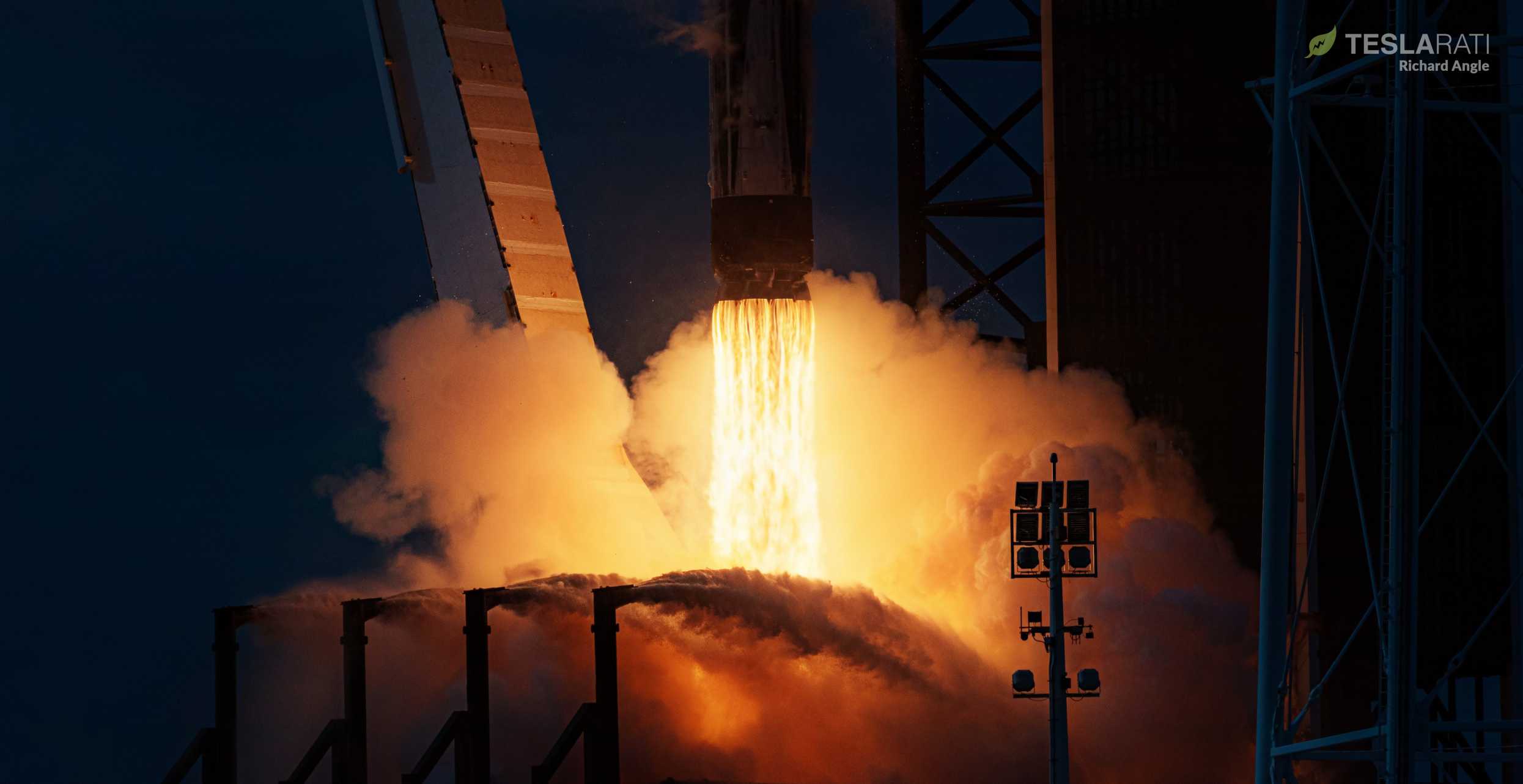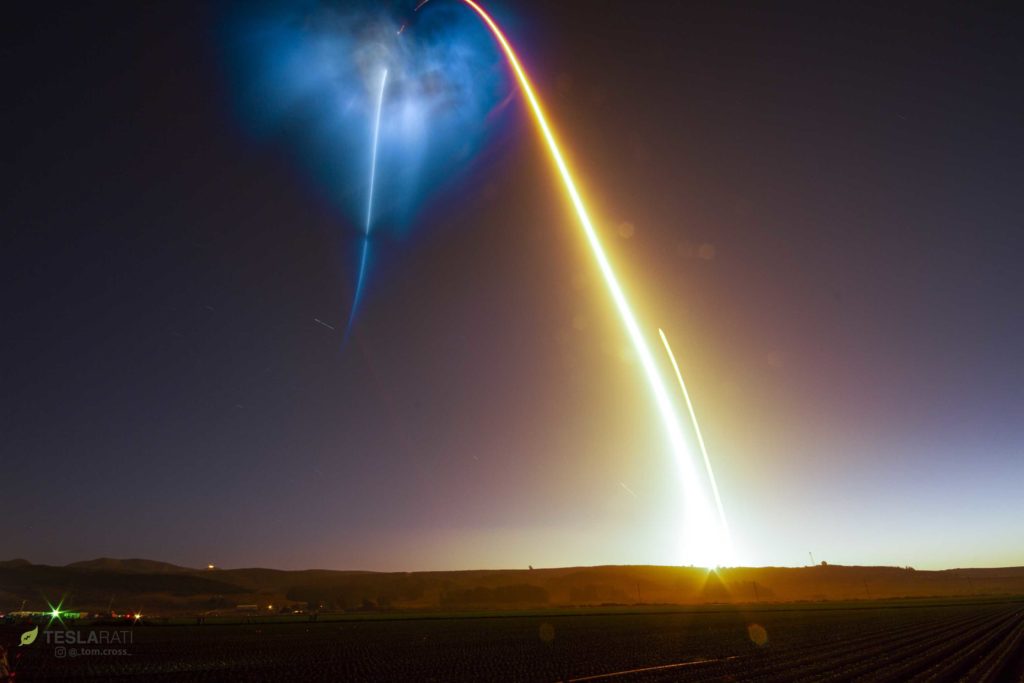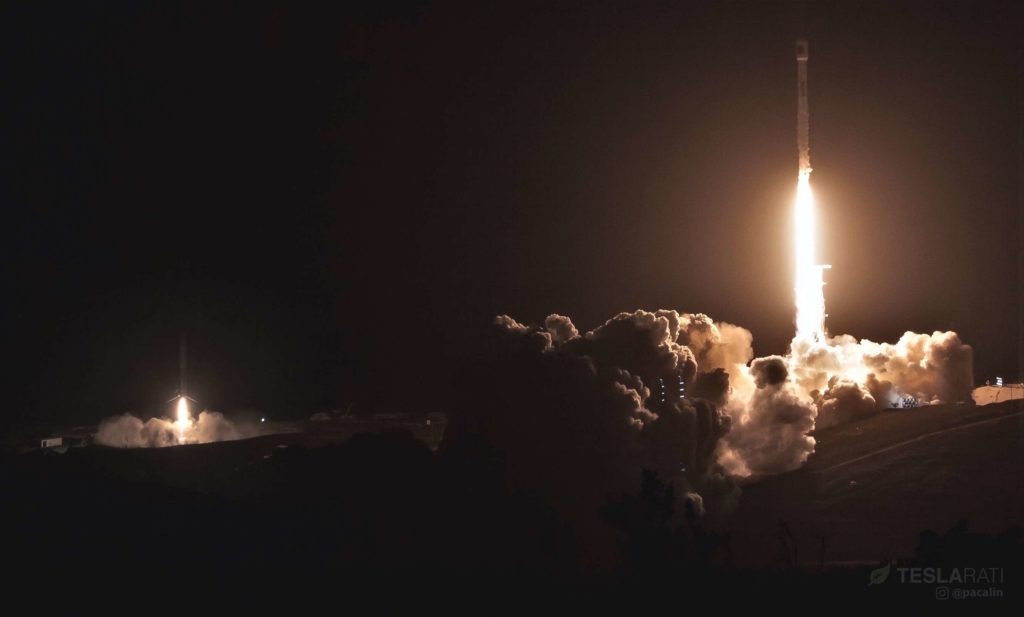

News
SpaceX sets date for first Florida launch of its kind in more than half a century
Argentinian space agency CONAE says that both its SAOCOM 1B satellite and SpaceX are on track for a type of launch that the United States’ East Coast hasn’t supported in more than half a century.
CONAE has revealed that SpaceX aims to launch the ~2800 kg (6200 lb) radar Earth observation satellite into orbit on a Falcon 9 rocket as early as March 30th, 2020 – late next month. With such a light payload, the Falcon 9 booster – presumably reused – will be able to perform a Return to Launch Site (RTLS) recovery, touching down at one of SpaceX’s two Landing Zone (LZ) pads located at Cape Canaveral Air Force Station (CCAFS). While Landing Zone rocket recoveries have become increasingly rare for SpaceX, that’s not actually why the SAOCOM 1B mission is so unique.
Instead, it’s exceptional because it will be the United States’ first East Coast polar launch in nearly six decades. The mission’s “polar” launch profile refers to the fact that the Argentinian radar satellite will ultimately orbit Earth’s poles, effectively perpendicular to more common equatorial orbits. If successful and repeatable, the mission could ultimately spark a new era for CCAFS and Kennedy Space Center (KSC) and raises big questions about the future of California’s Vandenberg Air Force Base (VAFB) — or at least SpaceX’s presence there.
Previously discussed on Teslarati late last year, the story behind why Cape Canaveral stopped polar launches is quite a weird one. A 2008 article in the Naval History Magazine sums up the events nicely.
“In what somewhat inaccurately became known as “the herd shot around the world,” some..falling rocket debris apparently splattered on a Cuban farm and killed a cow. “This is a Yankee provocation,” accused Revolucion, an official Cuban publication, insisting that the rocket was deliberately exploded over the country. Government radio stations cited the incident as further proof that the United States was trying to destroy the regime of Cuban President Fidel Castro. One cow was even paraded in front of the U.S. Embassy in Havana wearing a placard reading “Eisenhower, you murdered one of my sisters.”
Castro filed a complaint at the United Nations, and Washington sheepishly conceded the possibility that “fragments from the rocket booster” could have landed in Cuba. CIA Director George Tenet later quipped somewhat tastelessly that it was “the first, and last, time that a satellite had been used in the production of ground beef.” Further launches overflying Cuba were postponed, and improvements were made to the Cape Canaveral range-safety system. In any case, it was a dejected NRL group that returned to Washington.”
Naval History Magazine – April 2008
That November 1960 launch thus shut down East Coast polar launches to avoid overflying Cuba and raising the country’s ire near the height of Cold War tensions. It’s believed that the Cape actually launched two more semi-polar missions in the mid-1960s, some five years later, but the fact remains that SpaceX’s prospective March 30th, 2020 launch will mark the United States’ first East Coast launch in more than half a century.

Back in October 2019, while SpaceX had effectively confirmed that it would try to move SAOCOM 1B’s launch from California to Cape Canaveral, CCAFS hadn’t fully approved the change or literally reopened the East Coast’s polar launch corridor. Now, given that CONAE has officially announced a specific launch date (March 30th), it seems safe to say that CCAFS has fully given SpaceX the go-ahead for the launch.
While Falcon 9’s upper stage will still technically overfly Cuba over the course of the launch, the combination of a rare ‘dogleg’ maneuver shortly after launch and the fact that said upper stage will be far above the Earth’s surface have effectively mitigated any technical or legal showstoppers. Around eight minutes after liftoff, the mission’s Falcon 9 booster will also attempt to return to Florida and land at SpaceX’s LZ-1 or 2 landing pad. SpaceX’s October 2018 Vandenberg Air Force Base (VAFB) SAOCOM 1A launch coincidentally marked the first-ever use of Landing Zone-4 (LZ-4), a dedicated landing pad built for SpaceX’s West Coast launch site.

If successful, a polar Falcon 9 launch from Cape Canaveral also raises the question: if SpaceX can potentially perform all conceivable launch profiles from its two Florida pads, why go the effort and expense of maintaining a third pad – entirely dedicated to polar launches – in California? Aside from one lone launch six months later, SpaceX’s last California launch occurred in January 2019 and the next one is expected no earlier than November 2020 – and could very well never happen at all. The only plausible reasons to continue launching from SpaceX’s Vandenberg pad would be if Florida’s polar capabilities were somehow limited or if conservative, bureaucratic customers like NASA and the US military were dead-set on their polar missions only launching from semi-arbitrarily selected launch pads.
Without any modifications whatsoever, Falcon Heavy could also immediately begin performing polar launches from Cape Canaveral, whereas SpaceX would likely need tens of millions of dollars and 6-12 months to modify its California pad to support the massive rocket. Perhaps keeping that pad quietly mothballed and flying launch staff in from Florida and Texas for occasional missions is a much smaller ordeal than it seems. Still, the allure (and efficiency) of a one-stop-launch-shop at Cape Canaveral is almost certainly hard to ignore for a company like SpaceX.
For the SAOCOM 1B launch, the next milestone will be the Argentinian satellite’s arrival at SpaceX’s Florida payload processing facilities, likely to occur within the next week. Already, March is lining up to be an exceptionally busy month for SpaceX, with two separate Falcon 9 launches currently scheduled on March 2nd and March 4th and another Starlink mission likely later in the month. With a little luck, SpaceX might be able to end Q1 2020 with its first four-launch month ever.
Check out Teslarati’s Marketplace! We offer Tesla accessories, including for the Tesla Cybertruck and Tesla Model 3.
News
Tesla begins Robotaxi certification push in Arizona: report
Tesla seems serious about expanding its Robotaxi service to several states in the coming months.

Tesla has initiated discussions with Arizona transportation regulators to certify its driverless Robotaxi service in the state, as per a recent report from Bloomberg News. The move follows Tesla’s launch of its Robotaxi pilot program in Austin, Texas, as well as CEO Elon Musk’s recent comments about the service’s expansion in the Bay Area.
The Arizona Department of Transportation confirmed to Bloomberg that Tesla has reached out to begin the certification process for autonomous ride-sharing operations in the state. While details remain limited, the outreach suggests that Tesla is serious about expanding its driverless Robotaxi service to several territories in the coming months.
The Arizona development comes as Tesla prepares to expand its service area in Austin this weekend, as per CEO Elon Musk in a post on X. Musk also stated that Tesla is targeting the San Francisco Bay Area as its next major market, with a potential launch “in a month or two,” pending regulatory approvals.
Tesla first launched its autonomous ride-hailing program on June 22 in Austin with a small fleet of Model Y vehicles, accompanied by a Tesla employee in the passenger seat to monitor safety. While still classified as a test, Musk has said the program will expand to about 1,000 vehicles in the coming months. Tesla will later upgrade its Robotaxi fleet with the Cyercab, a two-seater that is designed without a steering wheel.
Sightings of Cybercab castings around the Giga Texas complex suggests that Tesla may be ramping the initial trial production of the self-driving two-seater. Tesla, for its part, has noted in the past that volume production of the Cybercab is expected to start sometime next year.
In California, Tesla has already applied for a transportation charter-party carrier permit from the state’s Public Utilities Commission. The company is reportedly taking a phased approach to operating in California, with the Robotaxi service starting with pre-arranged rides for employees in vehicles with safety drivers.
News
Tesla sets November 6 date for 2025 Annual Shareholder Meeting
The automaker announced the date on Thursday in a Form 8-K.

Tesla has scheduled its 2025 annual shareholder meeting for November 6, addressing investor concerns that the company was nearing a legal deadline to hold the event.
The automaker announced the date on Thursday in a Form 8-K submitted to the United States Securities and Exchange Commission (SEC). The company also listed a new proposal submission deadline of July 31 for items to be included in the proxy statement.
Tesla’s announcement followed calls from a group of 27 shareholders, including the leaders of large public pension funds, which urged Tesla’s board to formally set the meeting date, as noted in a report from The Wall Street Journal.
The group noted that under Texas law, where Tesla is now incorporated, companies must hold annual meetings within 13 months of the last one if requested by shareholders. Tesla’s previous annual shareholder meeting was held on June 13, 2024, which placed the July 13 deadline in focus.
Tesla originally stated in its 2024 annual report that it would file its proxy statement by the end of April. However, an amended filing on April 30 indicated that the Board of Directors had not yet finalized a meeting date, at least at the time.
The April filing also confirmed that Tesla’s board had formed a special committee to evaluate certain matters related to CEO Elon Musk’s compensation plan. Musk’s CEO performance award remains at the center of a lengthy legal dispute in Delaware, Tesla’s former state of incorporation.
Due to the aftermath of Musk’s legal dispute about his compensation plan in Delaware, he has not been paid for his work at Tesla for several years. Musk, for his part, has noted that he is more concerned about his voting stake in Tesla than his actual salary.
At last year’s annual meeting, TSLA shareholders voted to reapprove Elon Musk’s compensation plan and ratified Tesla’s decision to relocate its legal domicile from Delaware to Texas.
Elon Musk
Grok coming to Tesla vehicles next week “at the latest:” Elon Musk
Grok’s rollout to Tesla vehicles is expected to begin next week at the latest.

Elon Musk announced on Thursday that Grok, the large language model developed by his startup xAI, will soon be available in Tesla vehicles. Grok’s rollout to Tesla vehicles is expected to begin next week at the latest, further deepening the ties between the two Elon Musk-led companies.
Tesla–xAI synergy
Musk confirmed the news on X shortly after livestreaming the release of Grok 4, xAI’s latest large language model. “Grok is coming to Tesla vehicles very soon. Next week at the latest,” Musk wrote in a post on social media platform X.
During the livestream, Musk and several members of the xAI team highlighted several upgrades to Grok 4’s voice capabilities and performance metrics, positioning the LLM as competitive with top-tier models from OpenAI and Google.
The in-vehicle integration of Grok marks a new chapter in Tesla’s AI development. While Tesla has long relied on in-house systems for autonomous driving and energy optimization, Grok’s integration would introduce conversational AI directly into its vehicles’ user experience. This integration could potentially improve customer interaction inside Tesla vehicles.
xAI and Tesla’s collaborative footprint
Grok’s upcoming rollout to Tesla vehicles adds to a growing business relationship between Tesla and xAI. Earlier this year, Tesla disclosed that it generated $198.3 million in revenue from commercial, consulting, and support agreements with xAI, as noted in a report from Bloomberg News. A large portion of that amount, however, came from the sale of Megapack energy storage systems to the artificial intelligence startup.
In July 2023, Musk polled X users about whether Tesla should invest $5 billion in xAI. While no formal investment has been made so far, 68% of poll participants voted yes, and Musk has since stated that the idea would be discussed with Tesla’s board.
-

 Elon Musk1 week ago
Elon Musk1 week agoTesla investors will be shocked by Jim Cramer’s latest assessment
-

 Elon Musk3 days ago
Elon Musk3 days agoElon Musk confirms Grok 4 launch on July 9 with livestream event
-

 Elon Musk14 hours ago
Elon Musk14 hours agoxAI launches Grok 4 with new $300/month SuperGrok Heavy subscription
-

 News7 days ago
News7 days agoTesla Model 3 ranks as the safest new car in Europe for 2025, per Euro NCAP tests
-

 Elon Musk2 weeks ago
Elon Musk2 weeks agoA Tesla just delivered itself to a customer autonomously, Elon Musk confirms
-

 Elon Musk1 week ago
Elon Musk1 week agoxAI’s Memphis data center receives air permit despite community criticism
-

 Elon Musk2 weeks ago
Elon Musk2 weeks agoTesla’s Omead Afshar, known as Elon Musk’s right-hand man, leaves company: reports
-

 News2 weeks ago
News2 weeks agoXiaomi CEO congratulates Tesla on first FSD delivery: “We have to continue learning!”

















